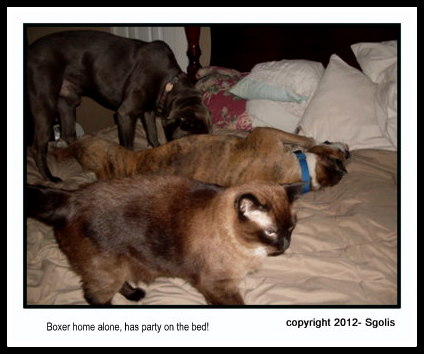A friend of mine’s is without a home right now so I told her I would watch her cat so she did not have to worry. I would provide day care for her feline immunodeficiency virus cat Missy. Cats with this health condition have special needs. They cannot go outdoors and they need to live a life that is peaceful with no exposure to healthy cats unless they get along and do not fight. A stressful situation could make the cat ill.
My cat Sam has Feline Immunodeficiency Virus and he lives a stress free life with no interaction with other cats because he is aggressive. I was not sure how Sam would react but soon found out that he was a welcoming host.
The cat is a female, not spayed and is just under a year old. Sam has never had a cat guest as he has not been in the same room with another cat since April 2009. I figure that they both have Feline immunodeficiency virus so they will not make each other ill, however I supervised their time together so that neither of them felt stress.
so they will not make each other ill, however I supervised their time together so that neither of them felt stress.
My cat Sam has Feline Immunodeficiency Virus and he lives a stress free life with no interaction with other cats because he is aggressive. I was not sure how Sam would react but soon found out that he was a welcoming host.
The cat is a female, not spayed and is just under a year old. Sam has never had a cat guest as he has not been in the same room with another cat since April 2009. I figure that they both have Feline immunodeficiency virus
I put the visiting cat in a crate
Sam did not care that the kitten was napping he was determined to get her attention so he sang to her for a few hours and then he brought her his toys. He searched his room until he found his favorite ball, the pen he took from my desk and his feather toys. He brought them one at a time and laid them at the base of the table that held the female kittens crate.
When Sam refused to eat, drink or take his afternoon nap I realized that he was putting his heart and love for this kitten before his health so I removed the kitten in the crate from his room. Sam stared out the glass door to view his beloved. He was satisfied that that she was okay so he then ate and went into his crate for a nap.
My friend picked her cat up later in the day and I let Sam out of his room to stretch his legs and to play with the family dog. He ran around the room; looking behind the drapes, under the sofa, and he scratched at the closet door. I am certain Sam was looking for her, the kitten that came into his life and tugged on his heart strings.
Sam did not want to play with the the family dog, nor did he want to play with his favorite toys. Sam left the living room and went back into his room and sat in his cat tree.
Sam did not want to play with the the family dog, nor did he want to play with his favorite toys. Sam left the living room and went back into his room and sat in his cat tree.
 | |


























